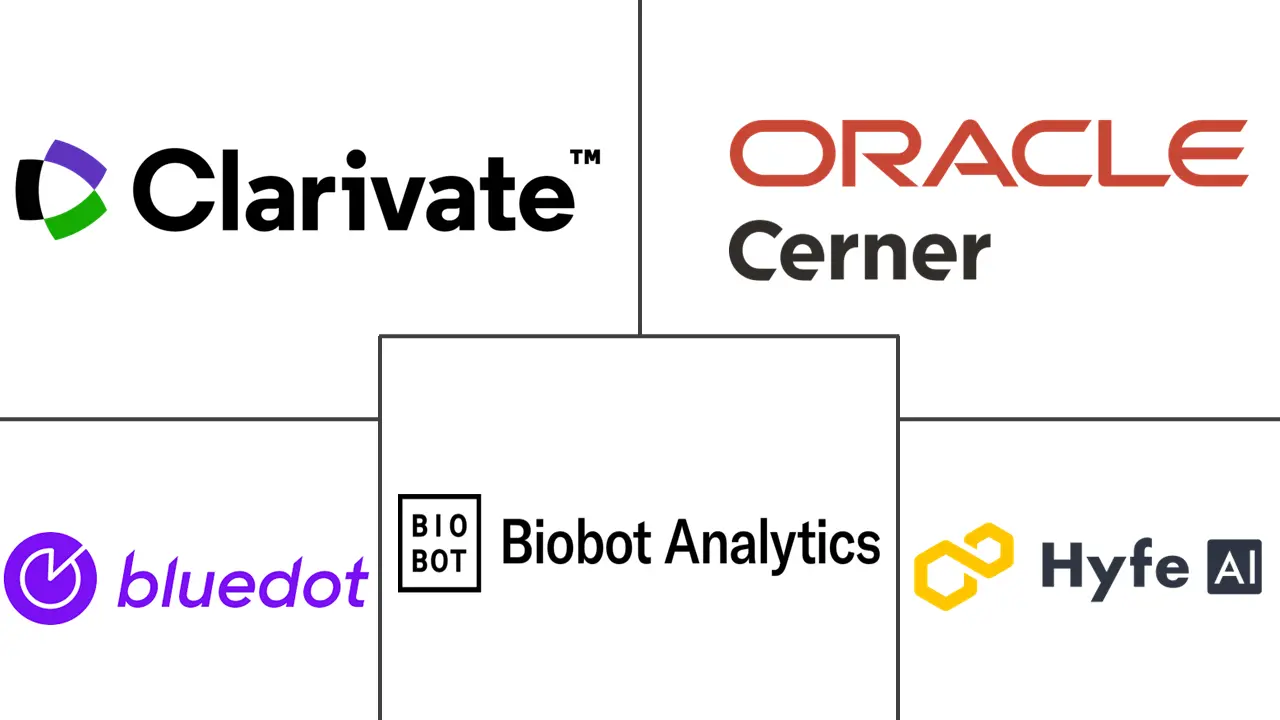AI In Epidemiology Market Size and Share
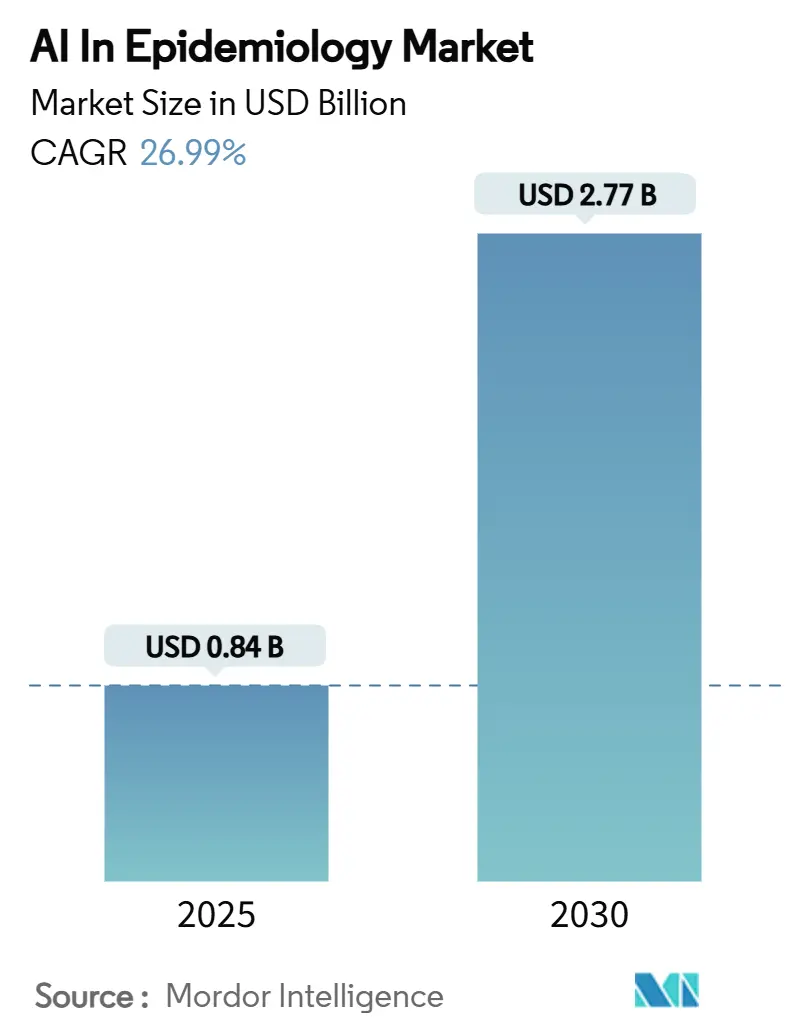
AI In Epidemiology Market Analysis by Mordor Intelligence
The AI in Epidemiology market size is valued at USD 0.84 billion in 2025 and is forecast to reach USD 2.77 billion by 2030, reflecting a 26.99% CAGR. The AI in Epidemiology market is expanding as public health authorities, life-science companies, and technology vendors incorporate advanced machine-learning, quantum-enhanced forecasting, and real-world data ecosystems into disease surveillance and response platforms. Ongoing federal funding, growing private investment, and increasingly mature cloud architectures are accelerating commercial adoption. Cloud deployment, dominance of government users, and leadership of machine-learning algorithms signal a transition from ad-hoc analytics toward integrated, predictive public-health intelligence. The AI in Epidemiology market now sits at the center of pandemic preparedness strategies, universal genomic surveillance, and antimicrobial-resistance mitigation, creating a multi-stakeholder environment where data access, compliance, and algorithmic transparency matter as much as technical performance[1]Centers for Disease Control and Prevention, “Respiratory Epidemiologic Surveillance Network,” cdc.gov.
Key Report Takeaways
- By deployment, cloud-based models held 61.23% of AI in Epidemiology market share in 2024 and are growing at 28.65% CAGR through 2030.
- By end user, government and state agencies commanded 35.67% of AI in Epidemiology market size in 2024, while pharmaceutical and biotechnology companies show the highest 29.54% CAGR.
- By AI technology, machine-learning algorithms led with 55.89% revenue share in 2024; deep-learning and neural-network solutions advance at a 28.01% CAGR.
- By application, infection prediction and forecasting accounted for 43.23% share of the AI in Epidemiology market size in 2024, whereas outbreak early-warning and response optimization grows fastest at 28.54% CAGR.
- By geography, North America represented 42.56% revenue share in 2024; Asia-Pacific is projected to expand at a 27.67% CAGR.
Global AI In Epidemiology Market Trends and Insights
Driver Impact Analysis
| Driver | % Impact on CAGR Forecast | Geographic Relevance | Impact Timeline |
|---|---|---|---|
| Accelerating digital health transformation | +4.2% | Global; North America and Europe leading | Medium term (2-4 years) |
| Growing burden of infectious diseases | +3.8% | Global; heightened in APAC and MEA | Long term (≥4 years) |
| Government investments in pandemic preparedness | +5.1% | North America, Europe with spillover to APAC | Short term (≤2 years) |
| Rising adoption of cloud computing in healthcare | +3.5% | Global; enterprise uptake in developed markets | Medium term (2-4 years) |
| Rapid expansion of real-world data ecosystems | +2.9% | North America and Europe core; expanding to APAC | Long term (≥4 years) |
| Emerging quantum-enhanced forecasting techniques | +1.8% | North American and European research hubs | Long term (≥4 years) |
| Source: Mordor Intelligence | |||
Accelerating Digital Health Transformation
Digital health transformation is redefining epidemiological surveillance through AI-powered systems that mine electronic health records, wearables, and social-media streams for early outbreak signals. Wastewater analytics from Biobot Analytics and acoustic epidemiology from Hyfe AI highlight how unconventional data channels now feed disease-prediction models. Integration of large language models with clinical repositories automates extraction of unstructured insights, tightening the alert-to-action cycle for public-health responders[2]. As these platforms mature, the AI in Epidemiology market continues its shift toward proactive risk mitigation.
Government Investments in Pandemic Preparedness
Governments now channel record capital into AI-centric biosurveillance. The United States has earmarked USD 211 million for emerging-pathogen platforms and committed USD 667 million to the global Pandemic Fund, with explicit objectives to shrink vaccine-development cycles. The Department of Defense incorporates algorithmic early-warning into threat-agnostic monitoring, while Europe’s AI Act mandates rigorous oversight for epidemiological AI systems. These policies strengthen near-term demand for compliant, scalable solutions across the AI in Epidemiology market.
Rising Adoption of Cloud Computing in Healthcare
Cloud architecture has become the backbone of AI model deployment, giving public-health agencies elastic compute capacity to run complex simulations and support federated learning without violating data-sovereignty rules. Microsoft’s Azure AI catalog and Amazon’s AWS Health AI modules package pre-configured epidemiological algorithms, which accelerates institutional uptake. Privacy-preserving encryption and differential-privacy layers allow multi-site collaboration under strict regulations, further boosting the AI in Epidemiology market.
Emerging Quantum-Enhanced Forecasting Techniques
Research teams in the United States and Europe use quantum-accelerated algorithms to improve cluster detection for HIV and other endemic threats, reporting balanced accuracy scores above 90%[3]arXiv preprint, “Quantum-accelerated HIV Cluster Forecasting,” arxiv.org. Although still experimental, such performance gains hint at significant long-term uplift for the AI in Epidemiology market once quantum resources become commercially viable.
Restraints Impact Analysis
| Restraints Impact Analysis | (~) % Impact on CAGR Forecast | Geographic Relevance | Impact Timeline |
|---|---|---|---|
| Data privacy & security concerns | -2.8% | Global; stricter in Europe and select APAC states | Medium term (2-4 years) |
| Limited skilled workforce | -3.2% | Global; acute in developing markets | Long term (≥4 years) |
| Algorithmic bias & health inequities | -1.9% | Global; higher scrutiny in developed markets | Medium term (2-4 years) |
| Fragmented cross-border data governance | -2.1% | Global; multi-jurisdiction challenges | Long term (≥4 years) |
| Source: Mordor Intelligence | |||
Data Privacy & Security Concerns
Rigorous statutes such as HIPAA, GDPR, and the EU AI Act classify epidemiological AI tools as high-risk applications that require continuous auditing, human oversight, and explainability. While federated learning and homomorphic encryption preserve confidentiality, stringent anonymization can reduce model accuracy, limiting the AI in Epidemiology market momentum in heavily regulated regions.
Limited Skilled Workforce
Implementation requires professionals fluent in epidemiology, data science, and regulatory compliance. Academic programs are expanding interdisciplinarity, yet global demand outstrips supply, especially in developing economies where surveillance needs are greatest[4]Frontiers in Education, “AI Workforce Gap in Public Health,” frontiersin.org. The talent gap slows deployment schedules and inflates service costs across the AI in Epidemiology market.
Segment Analysis
By Deployment: Cloud Dominance Accelerates
Cloud deployment generated USD 0.51 billion within the AI in Epidemiology market size in 2024, equal to 61.23% market share. The configuration offers elastic compute, global reach, and managed compliance, allowing health agencies to ingest petabyte-scale genomic streams and deliver real-time dashboards during outbreaks. Web-based and on-premises deployments persist inside defense installations and academic centers that prioritize data sovereignty.
Rapid migration to specialized healthcare clouds lifts forecast CAGR to 28.65%, supported by platform add-ons such as Azure’s medical-imaging models and AWS’s integrated biosurveillance pipelines. The AI in Epidemiology market increasingly favors multi-cloud and federated architectures that permit joint model training while keeping patient records local, resolving sovereignty constraints without scaling penalties.

Note: Segment shares of all individual segments available upon report purchase
By Application: Predictive Models Reshape Response Strategies
Infection prediction and forecasting generated 43.23% of AI in Epidemiology market revenue in 2024, valued at USD 0.36 billion within the AI in Epidemiology market size. Outbreak early-warning and response optimization ranks as the fastest-growing niche at 28.54% CAGR, propelled by mission-critical demand for sub-national risk alerts.
Large language models such as PandemicLLM synthesize policy, mobility, and genomic inputs to reach higher temporal-spatial accuracy than traditional compartmental models. Emerging quantum-enabled engines further push predictive horizons. Antimicrobial-resistance surveillance, once a secondary function, gains momentum as machine learning uncovers resistance genes at scale, embedding long-term growth into the AI in Epidemiology market.
By End User: Public-Private Convergence Accelerates
Government agencies contributed 35.67% to AI in Epidemiology market share in 2024 on the back of elevated federal grants and defense contracts. Pharmaceutical and biotechnology companies exhibit the sharpest advance at 29.54% CAGR as they integrate real-world evidence into drug-discovery and trial-optimization workflows.
Cross-sector collaborations, typified by the ARPA-H–Palantir alliance and the CDC’s extended Palantir deal, underscore mutual dependence between public health mandates and enterprise analytics. Academia and healthcare providers reinforce the AI in Epidemiology industry pipeline by trialing novel models and validating outcomes, thereby enhancing product credibility.
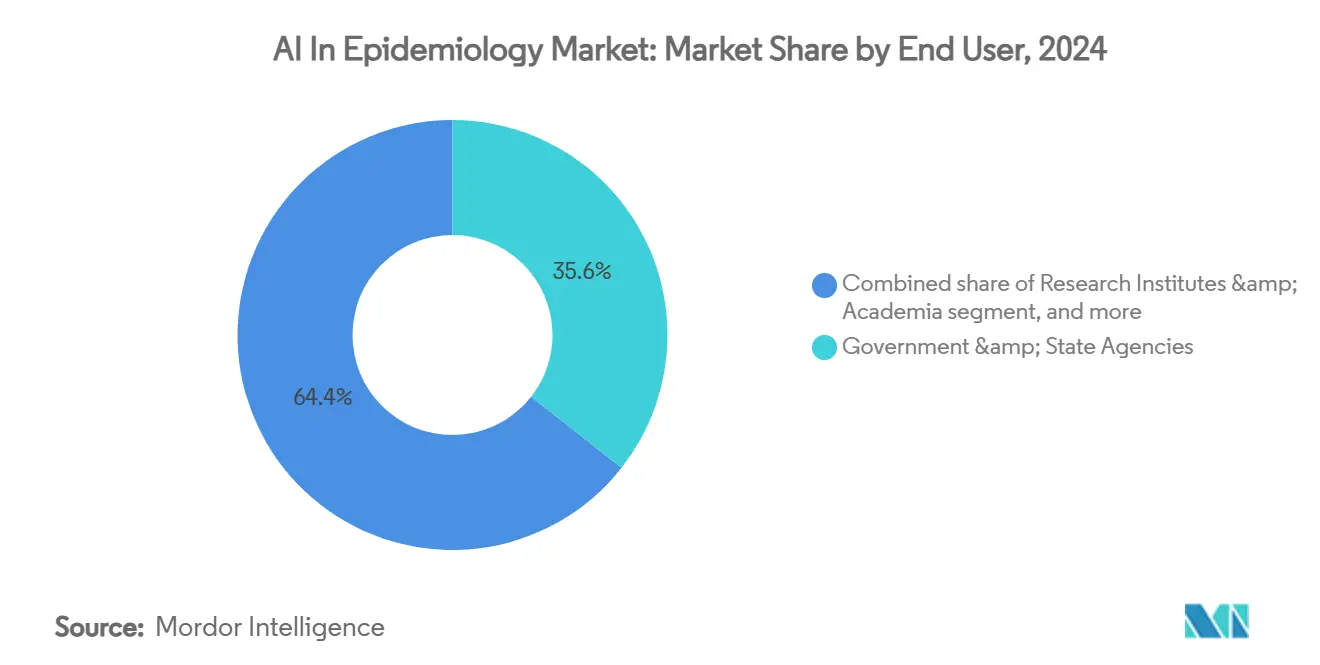
Note: Segment shares of all individual segments available upon report purchase
By AI Technology: Deep Learning Gains Momentum
Machine-learning frameworks maintained 55.89% revenue share in 2024, translating to USD 0.46 billion inside the AI in Epidemiology market size. Deep-learning and neural-network techniques, posting 28.01% CAGR, improve pattern recognition in complex, high-dimensional datasets.
Examples include DeepDynaForecast, which delivers 91.6% balanced accuracy in HIV-transmission prediction by processing phylogenetic graphs. Large language models and hybrid quantum optimizers diversify the toolkit, widening addressable use cases from social-media sentiment mining to computational vaccine design. Vendor differentiation increasingly hinges on proprietary pretrained models and compliance-ready deployment stacks.
Geography Analysis
North America produced 42.56% of 2024 revenue for the AI in Epidemiology market, powered by USD 211 million in U.S. federal funds for emerging-pathogen platforms and a USD 1.5 billion ARPA-H budget devoted to AI-driven health research. Federal agencies invest heavily in cloud-native biosurveillance infrastructure that integrates genomic, clinical, and environmental data streams, making the region the principal testbed for advanced epidemiologic AI solutions. Canada contributes through startups such as BlueDot, while Mexico’s digital-health modernization broadens regional datasets, further reinforcing continental leadership.
Europe represents a sizable segment shaped by stringent governance under the EU AI Act. Pan-European consortia allocate public grants to privacy-preserving research networks, stimulating demand for federated learning inside the AI in Epidemiology market. CEPI’s USD 1.1 million award to Apriori Bio for variant-resilient-vaccine design illustrates policy-backed momentum. Nevertheless, divergent national interpretations of GDPR temper deployment speed, compelling vendors to invest in adaptable compliance modules.
Asia-Pacific delivers the fastest regional CAGR at 27.67%. India forecasts a USD 1.6 billion AI healthcare opportunity, part of a USD 650 billion healthcare system by 2025. China rolls out city-wide digital-health grids and reports 22.78% job-performance gains among providers deploying AI tools. Approximately 600 regional startups enrich the AI in Epidemiology market with local-language models, mobile-first data capture, and cost-efficient cloud deployment. Governments across Japan, Australia, and Singapore subsidize national biosurveillance labs, cementing an ecosystem that elevates adoption curves.
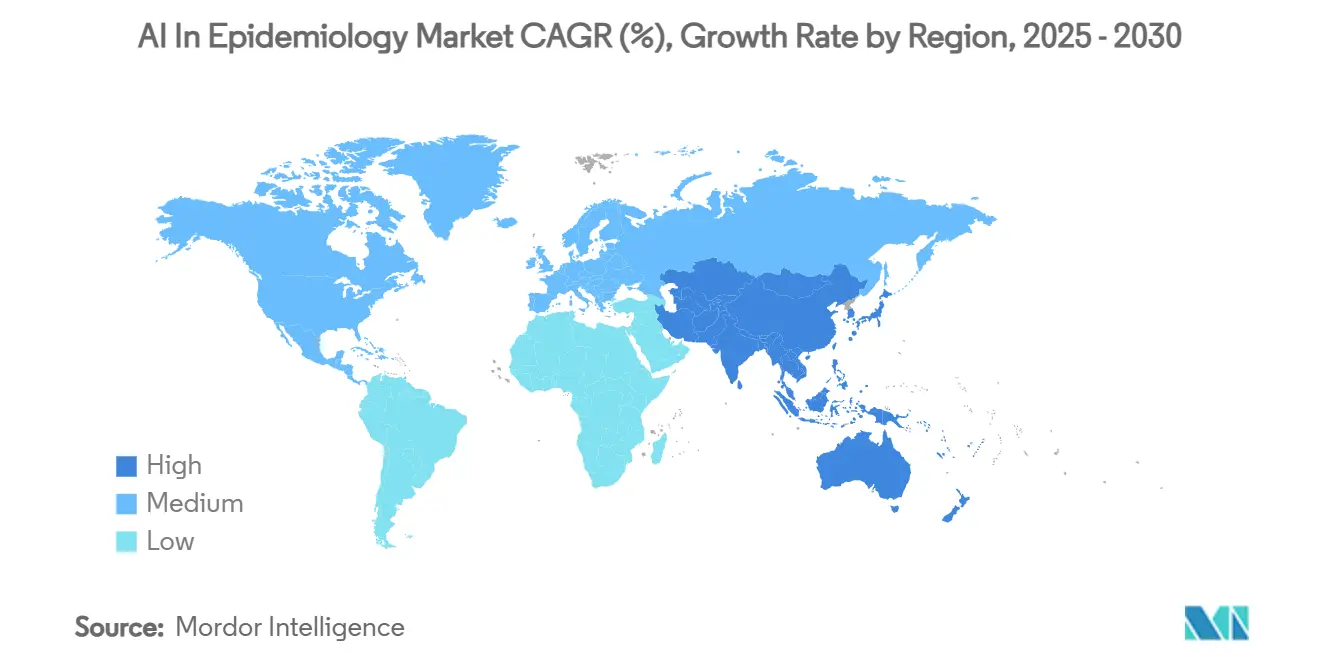
Competitive Landscape
The AI in Epidemiology market remains fragmented as specialized startups, platform giants, and public-sector labs compete on speed, data breadth, and compliance rigor. BlueDot, Metabiota, and Biobot Analytics win visibility through proprietary surveillance signals—international flight data, insurance-loss modeling, and wastewater analytics respectively. Meanwhile, Microsoft, Google, and Amazon integrate infectious-disease modules into horizontal cloud stacks, allowing customers to bolt AI epidemiology functions onto existing EHR and analytics estates.
Strategic government alignment often determines deal flow. Palantir Technologies secured a USD 19 million ARPA-H contract and expanded CDC usage of its Foundry platform, reinforcing trust credentials. Quantum-algorithm startups position for future upside by partnering with academic health centers on pilot projects that showcase compute advances in cluster detection. Barriers to scale include vendor-neutral accreditation frameworks, cross-border data-residency clauses, and the operational cost of continuous algorithm surveillance.
Mergers and venture funding center on bolt-on analytics and interoperability. Layer Health’s partnership with Intermountain Health underscores provider appetite for AI-powered registries. Syntropy’s collaboration with Evidium targets secure data-collaboration environments, reflecting the premium on privacy-centric architectures. As leadership criteria shift toward trusted data stewardship, vendors that demonstrate transparent model governance and robust cybersecurity controls retain competitive advantage in the AI in Epidemiology market.
AI In Epidemiology Industry Leaders
-
Clarivate
-
Oracle (Cerner Corporation)
-
Biobot Analytics
-
BlueDot
-
Hyfe AI
- *Disclaimer: Major Players sorted in no particular order
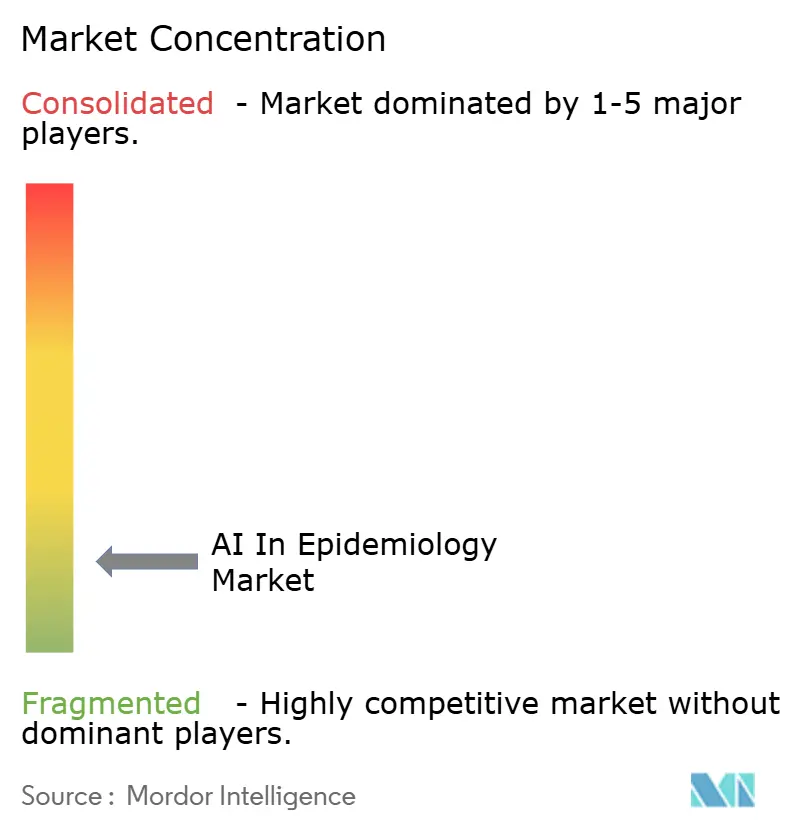
Recent Industry Developments
- January 2025: The U.S. Department of Health and Human Services announced USD 211 million in new funding for AI-driven surveillance and response systems.
- October 2024: Evidation Health was selected by Our Future Health as the participant platform for the United Kingdom’s largest health-research program.
- September 2024: John Snow Labs received a Phase I SBIR contract to develop medical large language models for infectious diseases.
- July 2024: Apriori Bio secured USD 1.1 million from CEPI to advance its Octavia™ AI platform for variant-resilient vaccines.
- July 2024: The U.S. Treasury pledged up to USD 667 million to the Pandemic Fund to strengthen AI-enhanced global surveillance.
Global AI In Epidemiology Market Report Scope
AI-based epidemiological surveillance is a promising approach to detecting, monitoring, and predicting the spread of diseases that employs AI technologies to analyze data from multiple sources, such as electronic health records, social media, and news articles.
The AI in the epidemiology market is segmented by deployment, application, end user, and geography. By deployment, the market is segmented into cloud-based and web-based. By application, the market is segmented into infection prediction and forecasting and disease and syndromic surveillance. By end user, the market is segmented into pharmaceutical and biotechnology companies, research institutes, government and state agencies, and healthcare providers. By geography, the market is segmented into North America, Europe, Asia-Pacific, and Rest of the World. The report offers values (USD) for all the above segments.
| Cloud-Based |
| Web-Based / On-Prem |
| Infection Prediction & Forecasting |
| Disease & Syndromic Surveillance |
| Outbreak Early-Warning & Response Optimization |
| Antimicrobial-Resistance (AMR) Monitoring |
| Pharmaceutical & Biotechnology Companies |
| Government & State Agencies |
| Research Institutes & Academia |
| Healthcare Providers |
| Machine-Learning (ML) Algorithms |
| Deep-Learning (DL) & Neural Networks |
| Large Language Models (LLMs) |
| Quantum & Hybrid Optimization |
| North America | United States |
| Canada | |
| Mexico | |
| Europe | Germany |
| United Kingdom | |
| France | |
| Italy | |
| Spain | |
| Rest of Europe | |
| Asia-Pacific | China |
| Japan | |
| India | |
| Australia | |
| South Korea | |
| Rest of Asia-Pacific | |
| Middle East & Africa | GCC |
| South Africa | |
| Rest of Middle East & Africa | |
| South America | Brazil |
| Argentina | |
| Rest of South America |
| By Deployment | Cloud-Based | |
| Web-Based / On-Prem | ||
| By Application | Infection Prediction & Forecasting | |
| Disease & Syndromic Surveillance | ||
| Outbreak Early-Warning & Response Optimization | ||
| Antimicrobial-Resistance (AMR) Monitoring | ||
| By End User | Pharmaceutical & Biotechnology Companies | |
| Government & State Agencies | ||
| Research Institutes & Academia | ||
| Healthcare Providers | ||
| By AI Technology | Machine-Learning (ML) Algorithms | |
| Deep-Learning (DL) & Neural Networks | ||
| Large Language Models (LLMs) | ||
| Quantum & Hybrid Optimization | ||
| Geography | North America | United States |
| Canada | ||
| Mexico | ||
| Europe | Germany | |
| United Kingdom | ||
| France | ||
| Italy | ||
| Spain | ||
| Rest of Europe | ||
| Asia-Pacific | China | |
| Japan | ||
| India | ||
| Australia | ||
| South Korea | ||
| Rest of Asia-Pacific | ||
| Middle East & Africa | GCC | |
| South Africa | ||
| Rest of Middle East & Africa | ||
| South America | Brazil | |
| Argentina | ||
| Rest of South America | ||
Key Questions Answered in the Report
What is the current value of the AI in Epidemiology market?
The AI in Epidemiology market is valued at USD 0.84 billion in 2025 and is projected to reach USD 2.77 billion by 2030 at a 26.99% CAGR.
Which deployment model leads the AI in Epidemiology market?
Cloud deployment leads with a 61.23% share in 2024 and is also the fastest-growing segment at 28.65% CAGR.
Why are governments the largest end-user group?
Government and state agencies hold 35.67% share because pandemic-preparedness funding prioritizes AI-enabled surveillance and rapid-response capabilities.
What geographic region grows fastest in this market?
Asia-Pacific records the highest regional CAGR at 27.67%, driven by India’s expanding digital health initiatives and China’s large-scale AI adoption.
How does data privacy regulation affect adoption?
Stringent frameworks such as GDPR and the EU AI Act classify epidemiological AI as high-risk, necessitating advanced privacy-preserving methods that can slow deployment.
Which technology area is emerging rapidly within the market?
Deep-learning and neural-network solutions grow at 28.01% CAGR as they enhance prediction accuracy for complex epidemiological events.
Page last updated on:
